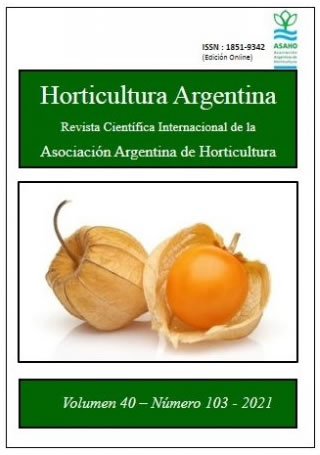Ver ítem
- xmlui.general.dspace_homeCentros Regionales y EEAsCentro Regional Tucumán - Santiago del EsteroEEA FamailláArtículos científicosxmlui.ArtifactBrowser.ItemViewer.trail
- Inicio
- Centros Regionales y EEAs
- Centro Regional Tucumán - Santiago del Estero
- EEA Famaillá
- Artículos científicos
- Ver ítem
Physalis (goldenberry): native fruit species of the sub-Andean Yungas with high cultivation potential in Argentina = Physalis (uchuva): especies frutales nativas de las Yungas subandinas con alto potencial de cultivo en Argentina
Resumen
El objetivo de esta revisión es destacar y poner en prospectiva el potencial y la factibilidad que tiene el cultivo de especies nativas de las Yungas subandinas, Physalis peruviana y P. pubescens, en Argentina. Ambas producen frutos de similares características entre sí, siendo casi indistinguibles. Algunas denominaciones del fruto son Physalis, uchuva, capulí, aguaymanto, Cape goosberry o goldenberry. Es una fruta exótica de creciente interés mundial,
[ver mas...]
El objetivo de esta revisión es destacar y poner en prospectiva el potencial y la factibilidad que tiene el cultivo de especies nativas de las Yungas subandinas, Physalis peruviana y P. pubescens, en Argentina. Ambas producen frutos de similares características entre sí, siendo casi indistinguibles. Algunas denominaciones del fruto son Physalis, uchuva, capulí, aguaymanto, Cape goosberry o goldenberry. Es una fruta exótica de creciente interés mundial, fundamentalmente por sus propiedades nutracéuticas y excelentes precios en Europa y EE.UU., donde se considera fruta “speciality”. Crece en ambientes con rangos térmicos de 5 a 35°C, con temperatura base de 6,29°C y óptima de 21°C. Necesita suministro de agua constante, con demanda en el rango de 1000 a 1800 mm de precipitación bien distribuidos durante el año. Las principales plagas son Epitrix cucumeris (Coleoptera), Chloridea (Heliothis) subflexa (Lepidoptera) y Liriomyza sp. (Diptera). El patógeno más importante es Fusarium oxysporum, le siguen Phoma sp., Pythium sp., Cercospora physalidis y Sclerotinia sclerotiorum. El fruto puede ser afectado por patógenos de postcosecha como Botrytis sp., Cladosporium, Pestalotia y Phomopsis. En Tucumán, INTA Famaillá realizó pruebas de adaptación con ambas especies de Physalis, verificándose su viablidad agronómica. El NOA se ha desarrollado como polo agroexportador de berries frescos hacia el hemisferio norte, donde también se encuentran los principales mercados consumidores de uchuva, constituyendo una oportunidad. La transformación de la uchuva permite la elaboración de productos estables sensorialmente agradables, que amplían las posibilidades de comercialización y permiten el agregado de valor (pulpa, néctares, jugos, mermeladas, deshidratados, barras energéticas, salsas, helados, etc.).
[Cerrar]
The objective of this review is to highlight the potential and feasibility of the cultivation of native species of the sub-Andean Yungas, Physalis peruviana and P. pubescens, in Argentina. Both species produce fruits with similar characteristics, being almost indistinguishable. Some names of the fruit are Physalis, cape gooseberry, capulí, aguaymanto, Cape goosberry or goldenberry. It is an exotic fruit of worldwide growing interest, mainly for its
[ver mas...]
The objective of this review is to highlight the potential and feasibility of the cultivation of native species of the sub-Andean Yungas, Physalis peruviana and P. pubescens, in Argentina. Both species produce fruits with similar characteristics, being almost indistinguishable. Some names of the fruit are Physalis, cape gooseberry, capulí, aguaymanto, Cape goosberry or goldenberry. It is an exotic fruit of worldwide growing interest, mainly for its nutraceutical properties and excellent prices in Europe and the US, where it is considered a "speciality" fruit. It grows in environments with thermal ranges from 5 to 35°C, with a base temperature of 6.29°C and an optimal temperature of 21°C, requiring a constant supply of water, with demands in the range of 1000 to 1800 mm of precipitation, well distributed throughout the year. The main pests are Epitrix cucumeris (Coleoptera), Chloridea (Heliothis) subflexa (Lepidoptera) and Liriomyza sp. (Diptera). The most important pathogen is Fusarium oxysporum, followed by Phoma sp., Pythium sp., Cercospora physalidis and Sclerotinia sclerotiorum. The fruit can be affected by postharvest pathogens such as Botrytis sp., Cladosporium, Pestalotia and Phomopsis. In Tucumán, INTA-Famaillá carried out adaptation tests with both Physalis species, verifying their agronomic viability. Argentina’s northwestern region has developed as an agro-export hub for fresh berries to the northern hemisphere, where the main consumer markets for goldenberry are located, constituting an opportunity. The processing of goldenberry allows the production of stable, sensory-pleasant products, broadening the possibilities of commercialization, and allowing the addition of value (pulp, nectars, juices, jams, dehydrated products, energy bars, sauces, ice cream, etc.).
[Cerrar]

Fuente
Horticultura argentina 40 (103) : 90-114. (Sep. - Dic. 2021)
Fecha
2021-12
Editorial
Asociación Argentina de Horticultura
ISSN
1851-9342 (Online)
Formato
pdf
Tipo de documento
artículo
Palabras Claves
Derechos de acceso
Abierto
 Excepto donde se diga explicitamente, este item se publica bajo la siguiente descripción: Creative Commons Attribution-NonCommercial-ShareAlike 2.5 Unported (CC BY-NC-SA 2.5)
Excepto donde se diga explicitamente, este item se publica bajo la siguiente descripción: Creative Commons Attribution-NonCommercial-ShareAlike 2.5 Unported (CC BY-NC-SA 2.5)


